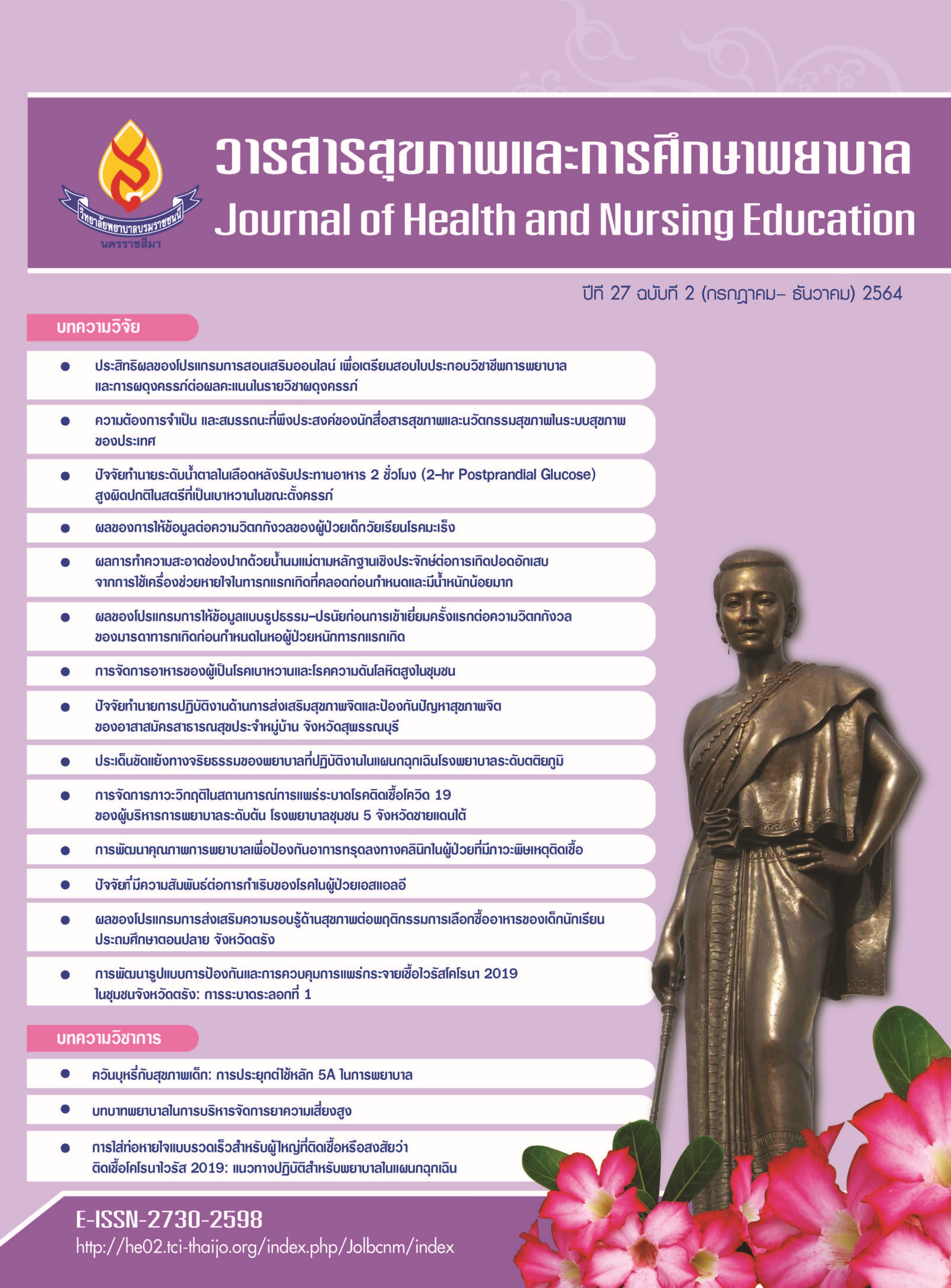ผลการทำความสะอาดช่องปากด้วยน้ำนมแม่ตามหลักฐานเชิงประจักษ์ต่อการเกิดปอดอักเสบจากการใช้เครื่องช่วยหายใจในทารกแรกเกิดที่คลอดก่อนกำหนดและมีน้ำหนักน้อยมาก
คำสำคัญ:
น้ำนมแม่, ทารกแรกเกิด, น้ำหนักตัวน้อยมาก, ปอดอักเสบจากการใช้เครื่องช่วยหายใจบทคัดย่อ
การเกิดปอดอักเสบจากการใช้เครื่องช่วยหายใจ (Ventilator-associated pneumonia [VAP]) เป็นปัญหาที่สำคัญและเสี่ยงต่อการเสียชีวิตในทารกแรกเกิดที่มีน้ำหนักตัวน้อยมาก การทำความสะอาดช่องปากด้วยน้ำนมแม่อาจช่วยลดภาวะดังกล่าวได้ การวิจัยกึ่งทดลองนี้มีวัตถุประสงค์เพื่อศึกษาผลของการทำความสะอาดช่องปากด้วยน้ำนมแม่ตามหลักฐานเชิงประจักษ์ต่อการเกิด VAP ในทารกแรกเกิดวิกฤตน้ำหนักน้อย ผู้เข้าร่วมการวิจัยคือ 1) ทารกแรกเกิดจำนวน 60 คน ที่คลอดก่อนอายุครรภ์ 37 สัปดาห์ น้ำหนัก 1,000-1,500 กรัม ที่ใช้เครื่องช่วยหายใจ และรับรักษาไว้ในห้องผู้ป่วยหนักทารกแรกเกิดของโรงพยาบาลแห่งหนึ่ง ใน จ.อุบลราชธานี และ 2) พยาบาลวิชาชีพที่ปฏิบัติงานในห้องผู้ป่วยทารกเกิดวิกฤตดังกล่าวจำนวน 13 คน แบ่งทารกแรกเกิดเป็นกลุ่มทดลอง (n = 30) ซึ่งได้รับการทำความสะอาดช่องปากด้วยน้ำนม และกลุ่มเปรียบเทียบ (n = 30) ซึ่งได้รับการทำความสะอาดช่องปากด้วยน้ำเกลือ เครื่องมือที่ใช้ในการวิจัย ประกอบด้วย 1) แนวปฏิบัติในการป้องกันการเกิด VAP ในทารกแรกเกิดตามหลักฐานเชิงประจักษ์ 2) แบบบันทึกการปฏิบัติ 3) แบบบันทึกการเกิด VAP และ 4) แบบประเมินความพึงพอใจ วิเคราะห์ข้อมูลด้วยสถิติบรรยาย และสถิติเปรียบเทียบ ผลการวิจัยพบว่า ทารกในกลุ่มทดลองเกิด VAP 9 ราย (ร้อยละ 30) ในกลุ่มเปรียบเทียบเกิด 14 ราย (ร้อยละ 46.6) แต่ไม่พบความแตกต่างกันของอัตราการเกิด VAP ทั้งสองกลุ่มอย่างมีนัยสำคัญทางสถิติ ที่ระดับ .05 (p = .18) สรุปได้ว่าน้ำเกลือหรือน้ำนมสามารถเป็นทางเลือกในการทำความสะอาดช่องปากทารกแรกเกิดที่น้ำหนักตัวน้อยมากและใช้เครื่องช่วยหายใจได้
เอกสารอ้างอิง
กฤษฎาภรณ์ ลบบำรุง, ทิพวัลย์ ดารามาศ, และจริยา วิทยะศุภร. (2562). ผลของการให้โคลอสตรุ้มทางปากต่อระดับอิมมูโนโกลบูลลินเอในทารกเกิดก่อนกำหนด. รามาธิบดีพยาบาลสาร, 25(1), 16-28.
งานป้องกันการติดเชื้อ. (2559). WI แนวปฏิบัติการป้องกันการเกิดปอดอักเสบจากการใช้เครื่องช่วยหายใจ.อุบลราชธานี: โรงพยาบาลสรรพสิทธิประสงค์.
ผกากรอง วนไพศาล. (2559). บทความเผยแพร่ความรู้สู่ประชาชน “น้ำนมแม่ประโยชน์อเนกอนันต์”. สืบค้นวันที่ 25 ธันวาคม 2563 จาก https://www.pharmacy.mahidol.ac.th/th/knowledge/article/338
เอื้องดอย ตันฑพงศ์, นพพร ไชยโยธา, และอาภัตรา ผการัตน์. (2556). วิจัยการศึกษาผลการใช้แนวทางปฏิบัติเพื่อการอย่าเครื่องช่วยหายใจในหอผู้ป่วยหนักศัลยกรรมทารกแรกเกิด. กุมารเวชสาร, 20(3),117-130.
Almuneef, M., Memish, Z. A., Balkhy, H. H., Alalem, H., & Abutaleb, A. (2004). Ventilator-associated pneumonia in a pediatric intensive care unit in Saudi Arabia: A30-month prospective surveillance. Infection Control and Hospital Epidemiology, 25(9), 753–758.
Bizzarro, M. J. (2012). Health care-associated infections in the neonatal intensive care unit: Barriers to continued success. Seminars in Perinatology, 36(6), 437–444.
Ceballos, K., Waterman, K., Hulett, T., & Makic, M. B. (2013). Nurse-driven quality improvement interventions to reduce hospital-acquired infection in the NICU. Advances Neonatal Care: Official Journal of the National Association of Neonatal Nurses, 13(3), 154-165. https://doi.org/10.1097/ANC.0b013e318285fe70
Cernada, M., Brugada, M., Golombek, S., & Vento, M. (2014). Ventilator-associated pneumonia in neonatal patients: An update. Neonatology, 105(2), 98–107.
Foglia, E., Meier, M. D., & Elward, A. (2007). Ventilator-associated pneumonia in neonatal and pediatric intensive care unit patients. Clinical Microbiology Reviews, 20(3), 409–425.
Gephart, S. M., & Weller, M. (2014). Colostrum as oral immune therapy to promote neonatal health. Advances in Neonatal Care: Official Journal of the National Association of Neonatal Nurses, 14(1), 44–51.
Kuti, B. P., Ogunlesi, T. A., Oduwole, O., Oringanje, C., Udoh, E. E., & Meremikwu, M. M. (2019). Hand hygiene for the prevention of infections in neonates. The Cochrane Database of Systematic Reviews, 2019(5), CD013326. https://doi.org/10.1002/14651858.CD013326
Ma, A., Yang, J., Li, Y., Zhang, X., & Kang, Y. (2021). Oropharyngeal colostrum therapy reduces the incidence of ventilator-associated pneumonia in very low birth weight infants: A systematic review and meta-analysis. Pediatric Research, (89), 54–62. https://doi.org/10.1038/s41390-020-0854-1
NemaRagab, Dabash, S. E., Rashad, H. M., & Iskander, I. (2018). Effect of oropharyngeal care using breast milk on the incidence of neonatal ventilator-associated pneumonia. Bioscience Research, 15(4), 4148-4152.
Rodriguez, N. A., Meier, P. P., Groer, M. W., Zeller, J. M., Engstrom, J. L., & Fogg, L. (2010). A pilot study to determine the safety and feasibility of oropharyngeal administration of own mother's colostrum to extremely low-birth-weight infants. Advances in Neonatal Care: Official Journal of the National Association of Neonatal Nurses, 10(4), 206–212.
Spatz, D. L. (2004). Ten steps for promoting and protecting breastfeeding for vulnerable infants. The Journal of Perinatal & Neonatal Nursing, 18(4), 385–396. https://doi.org/10.1097/00005237-200410000-00009
Thibeau, S., & Boudreaux, C. (2013). Exploring the use of mothers' own milk as oral care for mechanically ventilated very low-birth-weight preterm infants. Advances in Neonatal Care: Official Journal of the National Association of Neonatal Nurses, 13(3), 190–197.
Weber, C. D. (2016). Applying adult ventilator-associated pneumonia bundle Evidence to the ventilated neonate. Advances in Neonatal Care: Official Journal of the National Association of Neonatal Nurses, 16(3), 178–190.
Zhang, Y., Ji, F., Hu, X., Cao, Y., & Latour, J. M. (2017). Oropharyngeal colostrum administration in very low birth weight infants: A randomized controlled trial. Pediatric Critical Care Medicine: A Journal of the Society of Critical Care Medicine and the World Federation of Pediatric Intensive and Critical Care Societies, 18(9), 869–875.
ดาวน์โหลด
เผยแพร่แล้ว
ฉบับ
ประเภทบทความ
สัญญาอนุญาต
ลิขสิทธิ์ (c) 2021 วารสารสุขภาพและการศึกษาพยาบาล

อนุญาตภายใต้เงื่อนไข Creative Commons Attribution-NonCommercial-NoDerivatives 4.0 International License.
บทความที่ได้รับการตีพิมพ์เป็นลิขสิทธิ์ของ วารสารสุขภาพและการศึกษาพยาบาล ซึ่งดำเนินการโดยวิทยาลัยพยาบาลบรมราชชนนี นครราชสีมา
ข้อความที่ปรากฏในบทความในวารสารเล่มนี้เป็นความคิดเห็นส่วนตัวของผู้เขียนแต่ละท่านไม่เกี่ยวข้องกับกองบรรณาธิการวารสารสุขภาพและการศึกษาพยาบาล หรือวิทยาลัยพยาบาลบรมราชชนนี นครราชสีมา แต่อย่างใด ความรับผิดชอบองค์ประกอบทั้งหมดของบทความแต่ละเรื่องเป็นของผู้เขียนแต่ละท่าน หากมีความผิดพลาดใดๆ ผู้เขียนแต่ละท่านจะรับผิดชอบบทความของตนเองแต่ผู้เดียว







